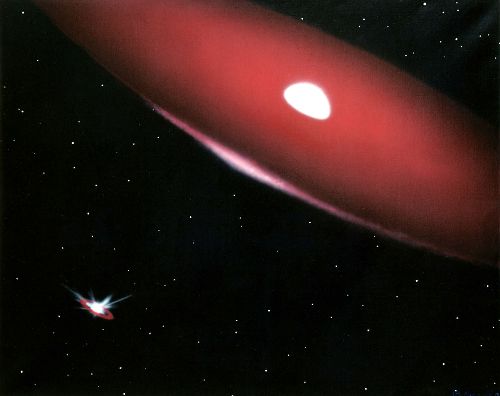Credit & Copyright: William Pounds
Explanation:
It's clear who is the biggest star in
this binary system.
Based on recent results,
this artist's vision of the double star
Phi Persei, 720 light years away,
shows a bright, rapidly rotating massive star
surrounded by a
disk of gas.
A small
companion star orbits 100 million miles away.
The bigger star is presently about 9 times more massive
than the small one ...
but it wasn't always this way.
Ten million years ago the small companion was actually the most massive
star in the system and
because of its greater mass evolved into a giant star more quickly.
After losing its swollen outer layers to the now massive star,
all that remains is a stripped down,
intensely hot core of about 1 solar mass.
In another ten million years, the roles may reverse as the
now massive star swells into its own giant phase "returning" mass to
its companion.
Will these stars end their lives as
white dwarfs or
supernovae?
Astronomers consider the ultimate fate of such
mass-exchanging, interacting
binary systems an open question and a challenge for present
theories of stellar evolution.
1999 2000 2001 2002 2003 2004 2005 2006 2007 2008 2009 2010 2011 2012 2013 2014 2015 2016 2017 2018 2019 2020 2021 2022 2023 2024 2025 |
Январь Февраль Март Апрель Май Июнь Июль Август Сентябрь Октябрь Ноябрь Декабрь |
NASA Web Site Statements, Warnings, and Disclaimers
NASA Official: Jay Norris. Specific rights apply.
A service of: LHEA at NASA / GSFC
& Michigan Tech. U.
|
Публикации с ключевыми словами:
stellar evolution - binary star - двойные звезды - Эволюция звезд - аккреционный диск - Тесные двойные системы
Публикации со словами: stellar evolution - binary star - двойные звезды - Эволюция звезд - аккреционный диск - Тесные двойные системы | |
См. также:
Все публикации на ту же тему >> | |
